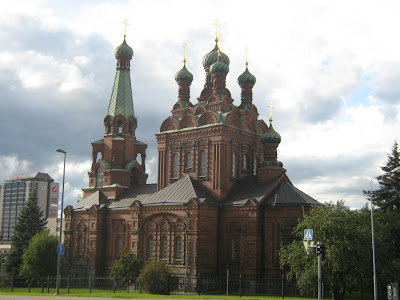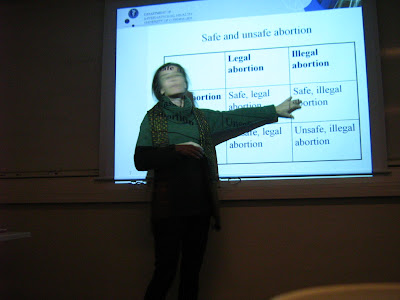Start to Finnish (3): The REAL Reason I am in Finland
 We just concluded week 2 of our five-week course here in Finland. Quite frankly, it took some getting used to to again be on the other side of the proverbial teacher’s table; but it is a welcome respite from my current work in the UP.
We just concluded week 2 of our five-week course here in Finland. Quite frankly, it took some getting used to to again be on the other side of the proverbial teacher’s table; but it is a welcome respite from my current work in the UP.  The Yliopisto’s main building.
The Yliopisto’s main building.  The Faculty of Information Science.
The Faculty of Information Science. “Parking slots” for the scores of bicycles transporting students to and from the university.
“Parking slots” for the scores of bicycles transporting students to and from the university.

We hold classes at the Tampereen Yliopisto- the University of Tampere main campus, at the third floor of its main building. The real university students are due to return this last week of August so as of late, we’ve practically had the university to ourselves.
Our typical school day begins with walking to school. And if the GPS in the car of one of our classmates who drove us to school one morning is correct, it’s a 900-meter walk, or 1.8 kilometers to and from the course’s venue. In my non-athletic, sedentary mind of minds, 1.8 kilometers is a HUGE amount of walking. Here in Tampere, though, walking is a rather pleasant experience: the air is fresh, with the number of motor vehicles arguably outnumbered by bicycles 7-3. The weather is almost always great for walking, sunny to a bit cloudy, with light winds, and the occasional late afternoon showers.

One of the landmarks we passby everyday: the Russian Orthodox church dedicated to St. Nicholas and St. Alexander Nevi. (More on this in later posts).


 Dr Per Ashorn- pediatrician, researcher, city council member, and uber-cool overall course coordinator.
Dr Per Ashorn- pediatrician, researcher, city council member, and uber-cool overall course coordinator. Dr. Vibeke Rasch of the University of Copenhagen discussing one of the more controversial topics of the course
Dr. Vibeke Rasch of the University of Copenhagen discussing one of the more controversial topics of the courseThe topics we have covered so far are truly representative of the current health concerns of any human being in the planet: poverty, accessibility of health systems, reproductive health, malnutrition, obesity, AIDS, vaccines and immunization. The lecturers are topnotch as well. Many have worked as consultants of international bodies like the World Health Organization and World Bank and/or embedded themselves in the grassroots communities of countries like Burkina Faso, Kyrghistan, Malawi, the Philippines and Vietnam. Many are part of think-tanks of world-renown, like-
 Dr. Anna Mia Ekstrom of the Karolinska Institute in Sweden who talked about poverty and health using the World Health Chart;
Dr. Anna Mia Ekstrom of the Karolinska Institute in Sweden who talked about poverty and health using the World Health Chart;




The participants, too, come from the broad spectrum of healthcare. The Philippine and Chilean contingent is composed of four medical doctors each; the Tanzania team has four medical doctors, two dentists, and two veterinarians, and; among the Finnish attendees, there are eight medical doctors, two dentists, and two veterinarians.
The mode of teaching is still generally via the usual didactics but there are almost daily group works, with the class divided usually by country or into groups where each country is represented by at least one student. The group work usually entail simulating decision-making tasks like how to put together a funding proposal for a project to combat malnutrition or how to select a new vaccine to be introduced to a certain country’s general population.
In a way, we get a better grasp of how difficult- or easy if there’s political will and/or money!- it is to make and implement public health policies. In preparation for our future work in the United Nations perhaps? =]
Up next: The OTHER reasons why I am in Finland
Labels: A sidetrip to Finland, photography, thinking aloud, travel







0 Comments:
Post a Comment
Thank you for visiting my blog!
You may also want to visit my photoblog a lonely planet it is not.
Have a great day!
<< Home